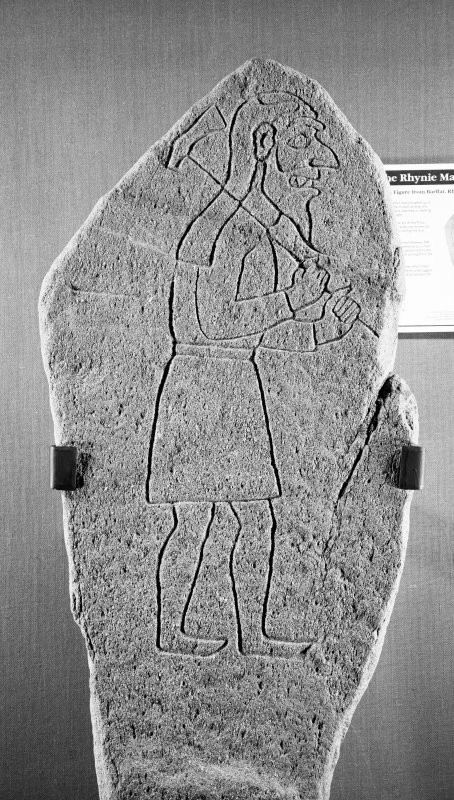
Appendix B
Who, or what, is the Rhynie Man?
This commentary originally prepared for inclusion into the intended book of collected writings related to the Turf to Tools project.

Complete carved stone, now at the Aberdeenshire Council Offices.
The stone is 1.78 m tall, the figure about human sized. (a)
During Turf to Tools Phase 1, visiting artist George Beasley related a tale that may have some bearing:
It seems that the river running through Rhynie is called the Bogie. As he told it, in years gone by (and perhaps even today?) mothers would attempt to keep children from misbehaving by threatening them with the 'Bogie Man'. (Pronounced b-OH-g-ee .) This was some kind of spectral figure who came from the marshy banks of the river, roaming abroad at night. The figure was most likely to appear on those days wreathed in fog, in the long uncertain light of twilight and dawn. The Bogie Man searched out 'evil' children, snatching them from their warm beds to haul them off to the river. There to drown, most likely their bodies never to be seen again.
George was certain this was the origin of the well known North American 'Boogie Man' (Pronounced b-EW-gee.) Despite several thousands of miles, several decades of distance- and two different countries, both of us remember this figure of dread from our own childhoods.
As George learned it in the southern USA in the 1940’s, the Boogie man dwelled invisibly under your bed or in your closet, only to become material when room lights were turned off at night. For many children of an earlier generation in the USA, sleep was impossible if a closet door was not firmly closed. The Boogie Man was the original 'monster under your bed' - waiting to snatch unwary children, who would be carried off with no trace remaining.
I had learned the tale in 1960's Ontario, where the Boogie Man lived around the dark corners behind your furnace, again invisible in the presence of any lights. This is especially curious, as I grew up with small, sealed box like furnaces burning piped in natural gas or oil. I certainly had seen the earlier monstrous octopus like mechanisms, originally intended for burning coal. Those a more obvious hiding place with their groans and bangs. Long converted to run on oil or replaced, coal burning was unknown by late 50's - early 60's Ontario. My childhood Boogie Man was a misshapen creature of tentacles, claws and slime - hardly recognizable as the gaunt and shadowy human figure of simpler times.
With his large beak like nose and shark like teeth, could the Rhynie Man be an
early rendition of the 'Bogie Man', marking not only a
traditional, but back to a still earlier 'ancient',
terror?
In preparing this piece, I did a (very quick) internet
search for 'Bogie Man'.
At least according to the descriptive article on Wikipedia, the concept of 'the man under the bed' appears almost universal. It is hard to tell where the concept might have first arisen, though the earliest references seem to be either Greece / Eastern Europe or, more interestingly, the Germanic regions. The tradition as given from these Germanic / Scandinavian roots:
" In Germanic countries, the bogeyman is called the butzemann, busseman, buhman or boeman. ... The common German expression is "der schwarze Mann" (the black man in English), which refers directly to some inhuman or rather paranormal creature, which carries children away and hides in the dark corners under the bed or in the closet. ...
In Denmark, it is known as the busseman or Bøhman. It hides under the bed and grabs children who will not sleep. Like the English, it is also a slang term for nasal mucus. In Norrway, he is referred to as the Busemann. In the Netherlands, the Boeman is portrayed as a creature that resembles a man, dressed completely black, with sharp claws and fangs. He hides under the bed or in the closet. The Bogeyman takes bad children or those that refuse to sleep and locks them in his basement for a period of time. " (1)
The suggestion is made that this tradition was more likely transported via early Germanic ('Pennsylvania Dutch') settlers to North America.
At least according to the Wiki entry, there is only one (?) other English based reference :
"In Yorkshire, young children were warned that if they stole from orchards, they might be eaten by a fairy in the form of a giant caterpillar called Awd Goggie."
Dr. Gordon Noble had told us that the original placement of the standing Rhynie Man Stone would have been outside the enclosure, perhaps marking a boundary along the track way leading to the settlement. Was this intended to warn trespassers of what might await them inside the enclosure? Or a warning of what might await outside the protection of this regional power centre? Remembering yet again that the Rhynie Man stone is roughly contemporary with the 'Saxon Shores' invasions of the 500 – 600's. Is this caricature then the feared figure of a Saxon or early Norse invader, awaiting 'beyond the boarders'?
References
a) Unknown, Rhynie Woman Archive Project, (2000 + ?), 'Rhynie Man, Rhynie – a Very Royal Place', used without permission : https://rhyniearchive.openvirtualworlds.org/artefacts/rhynie-man/
1) Unknown,
Wikipedia, (ND), 'Bogeyman', web site, last
accessed 8/14/23 :
http://en.wikipedia.org/wiki/Bogie_man